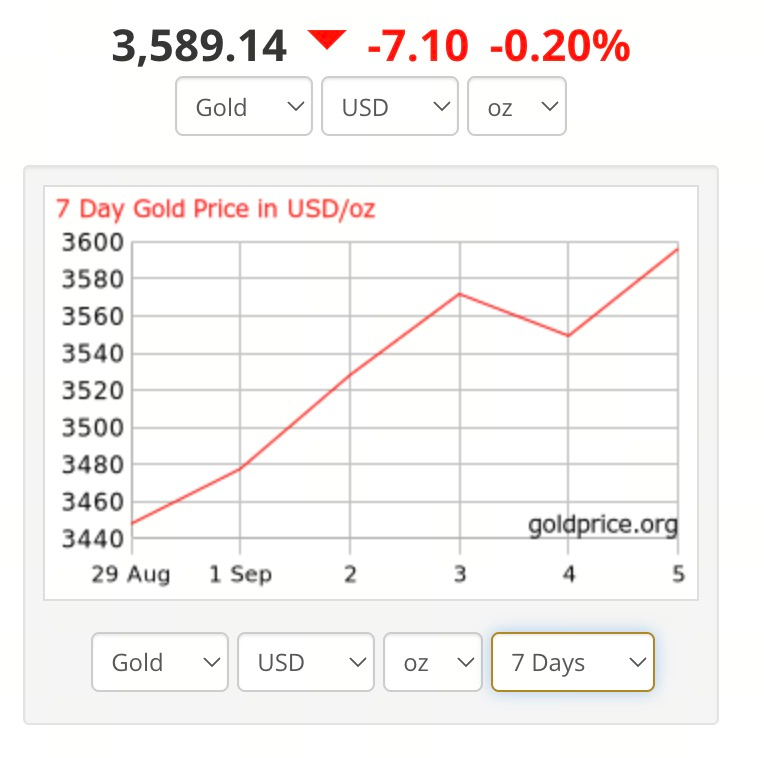Giá vàng vượt ngưỡng: 3.606,6 USD lập kỷ lục cao nhất mọi thời đại
Giới thiệu Giá Vàng Lập Kỷ Lục Mới
Giá vàng đã vượt qua mức đỉnh lịch sử trước đó, tăng lên trên 3.600 USD/ounce và đạt 3.606,6 USD. Đợt tăng giá mang tính lịch sử này đã thu hút sự quan tâm rộng rãi trên thị trường, khiến các nhà đầu tư tập trung phân tích những động lực chính và đánh giá triển vọng sắp tới.
Phân tích các Động lực Chính
Dữ liệu Việc làm Mỹ Kém Khả quan
Báo cáo việc làm phi nông nghiệp mới nhất của Mỹ gây thất vọng lớn khi chỉ tạo thêm 22.000 việc làm so với dự báo 75.000. Cùng lúc đó, tỷ lệ thất nghiệp tăng lên 4,3%—mức cao nhất kể từ năm 2021. Những số liệu này khiến thị trường càng lo ngại về nguy cơ kinh tế suy thoái, đồng thời làm gia tăng nhu cầu đối với các tài sản an toàn như vàng.
Kỳ vọng Fed Giảm lãi Suất
Dữ liệu việc làm yếu kém đã nâng cao kỳ vọng rằng Cục Dự trữ Liên bang (Fed) có thể hạ lãi suất ở cuộc họp sắp tới. Thị trường dự báo rộng rãi về khả năng Fed giảm 25 điểm cơ bản tại cuộc họp ngày 17/09, và xác suất 16% cho việc giảm 50 điểm cơ bản. Lãi suất thấp thường làm giảm chi phí cơ hội khi nắm giữ vàng, qua đó tạo động lực hỗ trợ giá vàng tăng lên.
Bất ổn Kinh tế Toàn cầu
Bên cạnh dữ liệu kinh tế từ Mỹ, tình trạng bất ổn trên toàn cầu vẫn là yếu tố thúc đẩy mạnh mẽ đà tăng của giá vàng. Nguy cơ địa chính trị, căng thẳng thương mại và xu hướng nới lỏng chính sách tiền tệ tại các nền kinh tế lớn đều khiến nhà đầu tư tìm đến vàng như một kênh trú ẩn an toàn.
Phân tích Kỹ thuật
Xét về khía cạnh kỹ thuật, vàng đã hình thành vùng hỗ trợ mới sau khi phá vỡ ngưỡng kháng cự trọng yếu trước đó tại 3.500 USD. Hiện tại, mốc 3.600 USD đang là vùng hỗ trợ chủ chốt. Nếu giá vàng tiếp tục giữ vững trên mức này, khả năng hướng lên 3.700 USD và xa hơn nữa là hoàn toàn có thể xảy ra.
Chiến lược Dành cho Nhà đầu tư
Quản lý Rủi ro
Dù xu hướng tăng giá của vàng hiện rất mạnh mẽ, nhà đầu tư vẫn cần cảnh giác với biến động thị trường. Nên đặt lệnh cắt lỗ (stop-loss) để phòng ngừa thua lỗ không đáng có do biến động giá ngắn hạn.
Khuyến nghị Đầu tư Ngắn hạn và Dài hạn
Nhà đầu tư dài hạn có thể cân nhắc mở hoặc tăng vị thế mua tại vùng giá hiện tại. Nhà giao dịch ngắn hạn nên linh hoạt ứng phó với biến động, chủ động điều chỉnh vị thế khi cần thiết.
Kết luận Triển vọng Thị trường Vàng
Giá vàng tăng mạnh cho thấy sự lo ngại kéo dài về nguy cơ kinh tế suy thoái và bất ổn thị trường. Nếu Fed tiếp tục duy trì quan điểm chính sách tiền tệ nới lỏng, giá vàng nhiều khả năng sẽ còn tăng thêm. Tuy vậy, nhà đầu tư nên thận trọng, chủ động theo dõi diễn biến thị trường và điều chỉnh chiến lược đầu tư một cách linh hoạt, hợp lý.
Bài viết liên quan

Hướng dẫn Xác minh KYC Pi Coin: Làm thế nào để vượt qua nhanh chóng

Dự đoán giá Solana năm 2025: SOL có thể đi lên cao đến đâu?

Hiểu về đồng tiền Baby Doge trong một bài viết

Những diễn biến mới nhất của Cardano (ADA)

Giá trị PI Crypto: Ra mắt Mạng chính vào ngày 20 tháng 2 năm 2025 & Dự đoán giá trong tương lai



